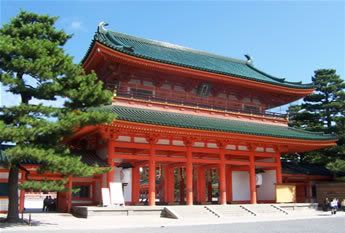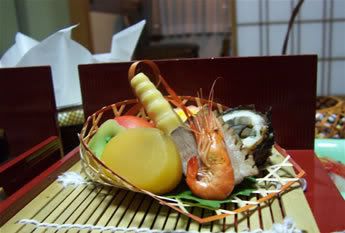The Heian Shrine, Kyoto
Japan has two major religions - Shinto and Buddhism - and most Japanese practice at least both (and some Christianity and Confucianism as well). Kyoto has hundreds of shrines and temples, many dotted in the forested hillsides that ring the city. The Nanzen-ji temple in Eastern Kyoto is a good example. Originally built in 1291 it was razed during a civil war in the 1400's. The buildings there today date from 'only' 400yrs ago, but walking around the huge pagodas it seems as if they have been there for many hundreds of years more. We paid Y500 (GBP2) and climbed a two-story gatehouse - in our socks as it is part of the Buddhist temple building. Another Y500 bought us tea in an adjacent building - but it was very different to a cup of Earl Grey and a digestive. We knelt, shoeless, in front of a waterfall framed by a dark green garden. A kimono-clad woman appeared and knelt on the tatami matting in front of us, presenting us with an earthenware bowl of foamy green tea (ocha) and a carefully wrapped sticky sweet.
The Tetsugaku-no-michi (Path of Philosophy) is apparently a good place for a contemplative stroll. We wandered along as a route between temples, looking at the cherry trees the Japanese have a particular fondness for, and the small fish, swimming frantically against the strong current in the stream. The path finished at Ginkakuji, created in 1482 as a weekend retreat by a Shogun. He wanted to cover the two-story pavilion in silver, but the tough nature of the Shogunate life claimed him before he could sign the cheque. The grounds were interesting though, being dominated by moss. There were labelled displays of the particular 'very important moss' that carpeted the forest floor. Gardeners were on hand, performing minute weeding underneath the trees.
Just one of the dishes for dinner
Traditional Japanese guesthouses are called ryokans. Ours is reasonably modern in parts, but the rooms are all tatami matting and you sleep on futons (pronounced 'huton' as the Japanese haven't an equivalent for the letter F) laid out on the floor. We changed into long cotton yukata robes printed with a jazzy white and blue pattern. Dinner was served in our room - just my Dad and me seated at a low table, with the elderly hostess distributing our food. After carefully (and exactly) arranging our dishes, she bowed and left us to it.
The food was amazing - almost like a Japanese form of tapas - many delicate bowls and plates of sashimi, tofu, egg, soup and tempura. It all looked far too good to eat, the preparation time must have been incredible. It all tasted good as well - despite over half of what we ate being simply unrecognisable. Of course you can identify a raw prawn (they melt in your mouth as you eat them) - but there were blobs of this and cubes of that which we couldn't even determine if it was animal or vegetable. It's an odd experience eating something that you can't identify - but certainly makes dining more exciting...